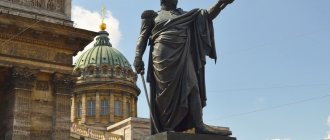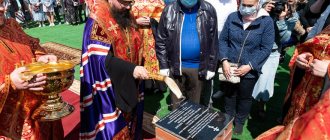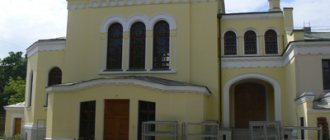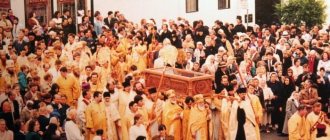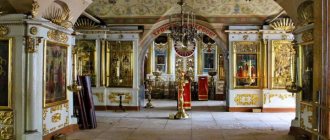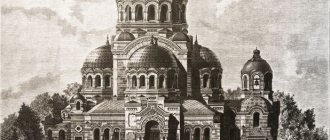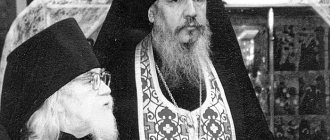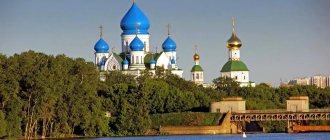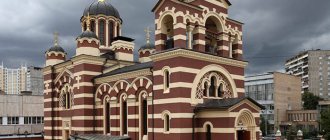Mir
Russia Tver region Gorbasyevo village Temple of the Georgian Icon of the Mother of God (Gorbasyevo) Map is loading…
{"format":"leaflet","minzoom":false,"maxzoom":false,"limit":50,"offset":0,"link":"all","sort":[""], "order":[],"headers":"show","mainlabel":"","intro":"","outro":"","searchlabel":"\u2026 \u0441\u043b\u0435\ u0434\u0443\u044e\u0449\u0438\u0435 \u0440\u0435\u0437\u0443\u043b\u044c\u0442\u0430\u0442\u044b","default":"","import-annotation":false,"width ":"auto","height":"350px","centre":{"text":"","title":"""link":"","lat":56.60204999999999841975295566953718662261962890625,"lon": 36.73440000000000082991391536779701709747314453125,"icon":""},"title":"","label":"","icon":"","lines":[],"polygons":[],"circles":[ ],"rectangles":[],"copycoords":false,"static":false,"zoom":8,"defzoom":14,"layers":["OpenStreetMap"],"image layers":[] ,"overlays":[],"resizable":false,"fullscreen":true,"scrollwheelzoom":true,"cluster":false,"clustermaxzoom":9,"clusterzoomonclick":true,"clustermaxradius":80, "clusterspiderfy":true,"geojson":"","clicktarget":"","showtitle":true,"hidenamespace":false,"template":"","userparam":"","activeicon": "","pagelabel":false,"ajaxcoordproperty":"","ajaxquery":"","locations":[{"text":"\u003Cb\u003E\u003Ca href=\"/palomnik/%D0% A5%D1%80%D0%B0%D0%BC_%D0%93%D1%80%D1%83%D0%B7%D0%B8%D0%BD%D1%81%D0%BA%D0%BE% D0%B9_%D0%B8%D0%BA%D0%BE%D0%BD%D1%8B_%D0%91%D0%BE%D0%B6%D0%B8%D0%B5%D0%B9_%D0% 9C%D0%B0%D1%82%D0%B5%D1%80%D0%B8_(%D0%93%D0%BE%D1%80%D0%B1%D0%B0%D1%81%D1%8C %D0%B5%D0%B2%D0%BE)\» title=\»\u0425\u0440\u0430\u043c \u0413\u0440\u0443\u0437\u0438\u043d\u0441\u043a\u043e\u0439 \u0438\ u043a\u043e\u043d\u044b \u0411\u043e\u0436\u0438\u0435\u0439 \u041c\u0430\u0442\u0435\u0440\u0438 (\u0413\u043e\u0440\u0431\u 0430\u0441\u044c\u0435\u0432 \u043e)\»\u003E\u0425\u0440\u0430\u043c \u0413\u0440\u0443\u0437\u0438\u043d\u0441\u043a\u043e\u0439 \u0438\u043a\u043e\u04 3d\u044b\u0411\u043e\ u0436\u0438\u0435\u0439 \u041c\u0430\u0442\u0435\u0440\u0438 (\u0413\u043e\u0440\u0431\u0430\u0441\u044c\u0435\u0432\u043e)\u 003C/a\u003E\u003C/ b\u003E\u003Chr /\u003E\u003Ca href=\"/palomnik/%D0%A1%D0%B2%D0%BE%D0%B9%D1%81%D1%82%D0%B2%D0%BE: %D0%90%D0%BD%D0%BD%D0%BE%D1%82%D0%B0%D1%86%D0%B8%D1%8F\" title=\"\u0421\u0432\u043e\u0439 \u0441\u0442\u0432\u043e:\u0410\u043d\u043d\u043e\u0442\u0430\u0446\u0438\u044f\u003E\u0410\u043d\u043d\u043e\u0442\u0430 \u0446\u0438\u044f\ u003C/a\u003E: "'\u0426\u0435\u0440\u043a\u043e\u0432\u044c \u0413\u0440\u0443\u0437\u0438\u043d\u0441\u043a\u043e\u0439 \u0 438\u043a\u043e\u043d \u044b \u0411\u043e\u0436\u0438\u0435\u0439 \u041c\u0430\u0442\u0435\u0440\u0438"' \u043f\u043e\u0441\u0442\u0440\u043e\u04 35\u043d\u0430\u043d\u0430 \u043c\u0435\u0441\u0442\u0435 \u043f\u0440\u0438\u0448\u0435\u0434\u0448\u0435\u0439 \u0432 \u0432\u0435\u0442\u0445\u043e \u0441\u0442\u044c \u0434\u0435 \u0440\u0435\u0432\u044f\u043d\u043d\u043e\u0439 \u0446\u0435\u0440\u043a\u0432\u0438 1714 \u0433\u043e\u0434\u0430. \u0425\u0440\u0430\u043c \u0432 \u0441\u0442\u0438\u043b\u0435 \u044d\u043a\u043b\u0435\u043a\u0442\u0438\u043a\u0438 \u043 f\u043e\u0434\u0432\u043b\u0438 \u044f\u043d\u0438\u0435\u043c \u0442\u0440\u0430\u0434\u0438\u0446\u0438\u0439 \u0434\u0440\u0435\u0432\u043d\u0435\u0440\ u0443\u0441\u0441\u043a\u043e \u0433\u043e \u0437\u043e\u0434\u0447\u0435\u0441\u0442\u0432\u0430.","title":"\u0425\u0440\u0430\u043c \u0413\u0440\u0443\u0437 \u0438\u043d \u0441\u043a\u043e\u0439 \u0438\u043a\u043e\u043d\u044b \u0411\u043e\u0436\u0438\u0435\u0439 \u041c\u0430\u0442\u0435\u0440 \u0438 (\u0413\u043e\u0440\ u0431\u0430\u0441\u044c\u0435\u0432\u043e)","link":"","lat":56.60204999999999841975295566953718662261962890625,"lon":36.7344000000000 0082991391536779701709747314453125,"icon":""}],"imageLayers":[] }
56.602368; 36.735705
Russia, Tver region, Konakovsky district, Gorbasyevo village
Gorbasyevo village, Tver region
Russia
Church of the Georgian Icon of the Mother of God
built on the site of a wooden church built in 1714 that had fallen into disrepair. The temple is in an eclectic style influenced by the traditions of ancient Russian architecture. The only altar of the Georgian Mother of God was consecrated on October 9, 1860.
History[edit]
The village of Gorbasyevo, Vakhoninsky rural district, is located 4 kilometers south of the Donkhovka railway platform. According to the old administrative division (until the 1930s), it was part of the Novinskaya (then Sverdlovsk) volost of Klinsky district. In 1714, through the diligence of Prince Simeon Yuryevich Solntsev, a small wooden church was built here in the name of the Georgian Icon of the Mother of God. A priest, sexton and sexton served with her. According to the clergy register of 1788: “In the Klin district of the estate of Lieutenant Colonel Fyodor Vasilyev Sukhov-Kobylin in the village of Gorbasyevo, a church in the name of the Georgian Blessed Virgin Mary, single-altar, wooden, in hardness, mediocre utensils.” Due to the small number of parishes (about 30 parish households in the village of Gorbasyevo and the village of Polushkino) for the maintenance of the clergy since 1831, “139 rubles 97 kopecks in silver were allocated as an auxiliary salary.”
A wooden church (with a wooden bell tower) by the end of the 1850s. began to deteriorate and “threaten with a quick fall.” In March 1857, it was decided to build a new stone church with money raised by parishioners and the “church sum”, “with the excellent diligence and stewardship” of priest Vasily Lebedev. Special assistance was provided by the Minister of War, Adjutant General Nikolai Onufrievich Sukhozanet, who ordered the preparation of construction drawings and estimates (“from three to four thousand silver rubles”) for the construction of a new church. Part of the amount was contributed by his wife, the landowner of the village Gorbasyeva Evdoksia Vladimirovna Sukhozanet. According to the conclusion of the dean (priest of the Assumption Church in the village of Zavidovo, Alexander Ioannov Likhachev), “the location chosen for construction is convenient, solid, and decent based on its soil and location.” The sanctuary certificate was issued on May 30, 1857. Upon completion of construction - on October 9, 1860 - the only altar was consecrated in the name of the Georgian Icon of the Mother of God. The church was built in the spirit of eclecticism under the influence of the traditions of ancient Russian architecture.
At the request of the parishioners, every year on June 16, after the liturgy, a procession of the cross was held around the village and surrounding fields, in memory of “the severe hailstorm that devastated the rye and oat crops on June 16, 1882.”
The church was closed in the 30s of the 20th century. From its closure until the end of the 40s of the 20th century, the church was used as a warehouse. The interior was looted, the roof began to collapse.
In 2014, the restoration of the church began with the help of local residents, the foundation was strengthened, and the completion of the main volume was restored.
Temple of the Georgian Icon of the Mother of God in the village of Yakshino
Rector: Archpriest Evgeny Khmyrov
At the beginning of the 17th century, a wooden temple was built on the Chelvenka River. In the scribe books of 1627-1628. it says: “in the churchyard is the Church of the Intercession of the Most Holy Theotokos in Drevyana Kletski, a building for parish people; near the church in the courtyard there is priest Peter Ivanov...” How long this temple lasted is not known, but the graveyard that was attached to the temple was destroyed already in Soviet times. Nowadays, the village in which the temple was located has retained its historical name - Pokrovskoye. It is also known that by the time the new temple was built, the old wooden one “had fallen into disrepair.”
The village of Yakshino, Podolsk district, which is located next to the village. Pokrovskoe, belonged to Prince G.A. Volkonsky, who founded here, on the banks of the Chelvenki River, a stone church in honor of the Georgian Icon of the Mother of God. According to legend, at the site of the future construction of the temple, the prince had a vision of the Georgian icon of the Mother of God, highly revered at that time throughout Russia, after which he vowed to build a temple on this place. But the temple was completed by his son, Alexander Grigorievich Volkonsky. The petition of Prince Alexander Grigorievich, submitted in 1767 to Empress Ekaterina Alekseevna with a request for permission to carry out work on insulation and reconstruction of the temple, states that the temple was built in 1710. Later, in 1773, Prince Alexander Grigorievich Volkonsky was buried in the left aisle of the temple itself. His remains were found there in our time, during the clearing of the temple’s foundations, when restoration work was carried out. A burial was found with an amber pectoral cross, indicating that the deceased belonged to a princely family. From archival documents it became known that Prince Alexander, the son of Senator Prince Grigory Ivanovich Volkonsky, 68 representative of the third branch of the Volkonsky princes, was buried here, descended from Prince Feodor Feodorovich Tarussky, Prince Volkonsky, ( XV generation of the Rurik dynasty).
During Soviet times, the temple shared the fate of many other temples. Its last rector was priest Arkady Lobtsov. He was born on January 22, 1895 in the city of Pereslavl, Yaroslavl province. In 1909 he graduated from the Pereslavl Theological School, then, after working for 2 years as a messenger for a bailiff, he got a job as a psalm-reader. He served in the Red Army and was captured on the Polish Front in 1920. After captivity, he again became a psalm-reader. In 1922 he was ordained a priest in the Ivanovo-Industrial Region, where he served until 1929. From 1929 until his arrest, Father Arkady served in the Church of the Georgian Icon of the Mother of God in the village of Yakshino. Old-timers remember Father Arkady as an unusually kind and attentive person. He especially loved children: “he always had nuts in his pocket, which he generously gave us,” recalls one of the parishioners of the village. Yakshino. On January 27, 1938, priest Arkady Lobtsov was arrested and accused of anti-Soviet activities. Two false witnesses were found who slandered the priest. On February 11, Father Arkady was sentenced to death, and on February 17 he was shot at the Butovo training ground and buried in an unknown common grave. By the determination of the Holy Synod in 2002, Hieromartyr Arkady Lobtsov was canonized in the Council of New Martyrs and Confessors of Russia.
After the arrest of Father Arkady, the temple was orphaned, a new abbot was not appointed here - there was active atheistic activity in the area, and particularly heated debates took place around the Yaksha temple. The Chekhov Archive contains folders with documents about the closure of churches in the late twenties and early thirties. Some of the folders are thin: the priests of the community gave up quickly. Others contain many dozens of pages. But the thickest one is about attempts to close the temple in the village of Yakshino. This small temple greatly spoiled the victory report of the OGPU: “On January 1, 1930, three churches were closed,” “in February 1930, 16 churches and the David’s Hermitage monastery were closed.” To close the Church of the Georgian Icon, both youth and schoolchildren were involved, residents of nearby villages were involved in the process, but they were able to close it only after the arrest of the rector, priest Arkady. The temple itself stood until 1953.
In the spring of 1953, the chairman of the collective farm named after. Krupskoy comrade Solomatin unauthorizedly dumped the bell tower into the local cemetery, damaging some of the burials. The method of destruction chosen was barbaric: niches were knocked out above the foundation into which wooden stumps were inserted. Then the stumps were set on fire and the bell tower collapsed, pulling the vault of the temple with it. For damaging the graves, complaints were filed against the chairman to the executive committee. At a meeting of the executive committee of the Lopasnensky district council on May 30, 1953, it was decided to announce comrade. Solomatin is reprimanded and ordered to destroy the temple in order to avoid accidents. Then the temple was blown up. A sheepfold was built nearby from the bricks of the blown-up temple. The very site of the temple was forgotten and was soon overgrown with trees and bushes.
In the late 80s, a local artist became interested in the history of the temple. With the help of a resident of the village of Khodayevo, who had once participated in the destruction of the Yaksha temple, he found the place where the church was located, cleared it, and together they installed a worship cross here in order to mark the holy place and calm the languishing conscience of the former destroyer of the temple.
In 1998, the revival of the temple began. Based on archival documents, the appearance of the ancient shrine was recreated. On the old foundation, which in some places remained intact, construction began on a temple made of bricks from the same sheepfold that had already been dismantled. By 2004, the walls and vaults of the temple were removed and domes with crosses were installed. Then, in this still empty building, spiritual life was revived again. On September 4, on the patronal feast day, the first Liturgy was served in the church.
In 2007-2008 In the temple, full-scale work was carried out to paint the walls of the temple, and the domes were gilded.
The temple has three limits. The central one is dedicated to the Georgian Icon of the Mother of God, the northern one - to the Holy Supreme Apostles Peter and Paul and the southern one - to St. Nicholas, the Wonderworker of Myra. It is known that before the revolution, the miraculous Georgian icon of the Mother of God was located in the temple.
On September 19, 2009, the temple was consecrated by Metropolitan Juvenaly of Krutitsky and Kolomna.
The Sunday school building is currently being reconstructed. The area around the temple has also been landscaped. The territory of the adjacent cemetery has been landscaped.
https://yakshino.cerkov.ru
Great consecration of the Georgian Church in the village of Yakshino
by seoalena
February 24, 2014
in Articles
no comments
1267
The church in honor of the Georgian Icon of the Mother of God in the village of Yakshino, Chekhov district, has an ancient and difficult history. The temple was first mentioned in 1628 in scribe books as the wooden Church of the Intercession near the village of Venyukovo.
The village of Yakshino and the Church of the Intercession were on the estate of the Baryatinsky princes, who at the end of the 17th century ceded this part of their possessions to the ancient Volkonsky family.
The new owner, Grigory Ivanovich Volkonsky, one of Peter’s seven first senators, in 1711 asked the sovereign and the Holy Synod for permission to build a stone church in a new place - the reason was a miracle.
While hunting in his grounds on a hill, the prince saw the Georgian icon of the Mother of God floating in the air - this image then began to be especially revered in Rus'.
The wooden Church of the Intercession was already dilapidated, and Grigory Volkonsky considered that this was an instruction from the Mother of God herself to build a new stone church. By 1713, construction work at the site of the icon's appearance was largely completed. In addition to the Main Altar, there was a chapel of St. Nicholas the Wonderworker (not heated) and the Holy Apostles Peter and Paul (warm).
Later, the son of Grigory Ivanovich, Alexander Grigorievich Volkonsky, was buried in the Peter and Paul Chapel (his remains rest there to this day). It is known that before the revolution, the miraculous Georgian icon of the Mother of God was located in the temple.
During Soviet times, the temple shared the fate of many churches. Its last rector was priest Arkady Lobtsov. In 1938, he was arrested and shot at the Butovo training ground. By the determination of the Holy Synod, in 2002, Hieromartyr Arkady Lobtsov was canonized in the Council of New Martyrs and Confessors of Russia. The Georgian church stood closed and looted since 1938, but survived the Great Patriotic War.
In 1951, at a general meeting of the local collective farm and village council, it was decided to destroy the temple. A sheepfold was built nearby from the bricks of the blown-up temple. The very site of the temple was forgotten and was soon overgrown with trees and bushes.
In 1998, the revival of the church began. Initially, with the help of a “veteran” of the destruction of the temple, the site of the holy Altar was found and a worship cross was installed. Based on archival documents, the appearance of the ancient shrine was restored. On the old foundation, which in some places remained intact, the temple was rebuilt from bricks from the same sheepfold that had already been dismantled.
Since 2004, liturgical life has also been revived in the church - a rector has been appointed.
By 2009, carved gilded iconostases were created and magnificent icons were painted by isographer Pavel Pelevin.
In 2008, new bells were erected on the belfry. Under the leadership of A.N. Maskalionov, a member of the Union of Artists, the church acquired paintings on the walls and vaults, and restorers led by M.I. Kravchenko recreated the appearance of the temple: the walls were painted in the festive Moscow style of the late 17th - early 18th centuries, and the domes shone with gilding. The restoration was supervised by the temple's patrons: N.B. Pavlinov and O.A. Strekalov, with the direct participation of the first deputy head of the Chekhov district, S.V. Yudin. They consistently and scrupulously prepared the temple for the Great Consecration.
The joyful and long-awaited day of the second birth of the revived church, with the blessing of Metropolitan Juvenaly of Krutitsy and Kolomna, was September 19, 2009. The administrator of the Moscow diocese personally led the rite of the great consecration of the revived Georgian Church. Concelebrating with Vladyka Metropolitan were: dean of the monasteries of the Moscow Diocese, rector of the Ascension of David Hermitage Bishop Roman of Serpukhov, assistant to the Administrator of the Moscow Diocese for public affairs Archpriest Pyotr Ivanov, dean of the Chekhov church district priest Alexander Serbsky, rector of the Georgian Church priest Evgeniy Khmyrov, dean of the Lyubertsy church district archpriest Dimitry Murz Yukov , the head of the office of the Moscow Diocesan Administration, Hieromonk Peter (Dmitriev), the rector of the Vysotsky Monastery, Abbot Kirill (Kostikov), the dean of the Kashira church district, Archpriest Vitaly Kotsenko, as well as clergy of the Moscow diocese.
The following people prayed during the service: the head of the city of Chekhov V.E. Steperenkov, the chairman of the Council of Deputies of the Chekhov district M.A. Keselman, the first deputy head of the Chekhov district S.V. Yudin, the deputy head of the Chekhov district, the head of the education department E.N. Tolmacheva. Many pilgrims from the city of Chekhov and churches in the Chekhov region arrived at the temple to participate in the great consecration and Liturgy. At the end of the Divine Liturgy, the Metropolitan noted that the Georgian Church, revived by the diligent care of the patrons, should become a place of pilgrimage for children and youth: it has become not only a spiritual shrine, but a masterpiece of church art. Bishop Yuvenaly especially emphasized that the time has come to pay attention to our own Russian memorial sites, and to look less for “miracles” abroad.
Metropolitan Yuvenaly presented philanthropists Nikolai Borisovich Pavlinov and Oleg Alexandrovich Strekalov with patriarchal awards - the Order of the Holy Blessed Prince Daniel of Moscow, III degree. The rector of the temple, priest Evgeny Khmyrov, was awarded the medal of St. Sergius of Radonezh. In addition, artists, restorers and builders were awarded letters of gratitude and blessings from the governor of the Moscow diocese.
A separate award - an icon of St. Sergius of Radonezh was presented to the director of a boarding school for girls with deviant behavior A.G. Ustyuzhanin. The parish and personally Father Evgeniy, with the support of the director of the boarding school, have been caring for this special educational institution for a long time. The pupils were at the Divine service today. As a prayerful memorial to the parishioners of the Georgian Church, Metropolitan Juvenaly presented an icon of the holy martyr Arkady, the heavenly patron of the parish - he was glorified in his time with the direct participation of Metropolitan Juvenaly as the chairman of the Synodal Commission for the Canonization of Saints.
At the end of the celebrations, Vladyka Metropolitan inspected the parish territory - it now has an architectural layout, and the ancient cemetery has been landscaped.
In addition, through the diligence of N.B. Pavlinov, a wonderful house was built near the temple for the priest’s family - Vladyka Yuvenaly visited Father Evgeniy. The construction work is not yet complete: not far from the church, Nikolai Borisovich is restoring the old building of the parish Sunday school - it was built at the end of the 19th century and will again serve the parish children.
At the invitation of the rector of the Ascension David Hermitage, Bishop Roman and N.B. Pavlinov, Vladyka Metropolitan visited the Church of the Mother of God in the village of Talezh, Chekhov district.
This parish church and its separate bell tower were built by Count Orlov in the mid-19th century with the participation of the famous architect Kazakov.
The heavily damaged temple and belfry became the courtyard of the Ascension David's Hermitage in 2006 - now they are unrecognizable. Vladyka Roman and Nikolai Borisovich together are restoring the shrine: external restoration work has been completed, a new roof has been created and domed crosses are shining in gold, the territory has been landscaped and the parish necropolis of the 17-19th centuries is being developed. Metropolitan Yuvenaly was able to inspect the quality of the interior work: the temple acquired a new, previously lost, floor made of natural stone, and plastering work was completed. Now the temple is “drying out” - standing for many years without a roof is making its presence felt. On the eve of the patronal feast of the Nativity of the Virgin Mary, the clergy, led by the Metropolitan, sang the troparion and magnification of the holiday.
Saying goodbye to the restored temple, Vladyka Yuvenaly expressed hope that he would soon come here for the Great Consecration, and the benefactor builders promised not to weaken their restoration efforts. Its prospects in the Chekhov region are great: in recent decades, to the three churches that were not previously closed, 24 parishes and a monastery have been added. The celebrations in the Georgian church in the village of Yakshino again testify that everything is possible for believers, and the gates of hell will never prevail against the Church of God.
Priest Alexander of Serbia.
Share the news
seoalena
We recommend that you read
It is planned to prepare 220 places for Epiphany bathing in the Moscow region
January 14, 2021
Savvino-Storozhevsky Monastery in September
September 01, 2020
Torzhok is a wonderful city in the Tver province
July 27, 2020
Categories
- Videos from Talezh visitors (176)
- Prayer book (1,567)
- News (32)
- Orthodox church events (37)
- Articles (16)
More about the book
Calendar
February 2014
| Mon | W | Wed | Thu | Fri | Sat | Sun |
| 1 | 2 | |||||
| 3 | 4 | 5 | 6 | 7 | 8 | 9 |
| 10 | 11 | 12 | 13 | 14 | 15 | 16 |
| 17 | 18 | 19 | 20 | 21 | 22 | 23 |
| 25 | 26 | 27 | 28 | |||
about the project
The unofficial site about the Holy Spring in Talezh https://talezh1.ru is a socially useful information resource. All information is taken from the web archive, YouTube and other open sources.
Leave a review
Website creation and promotion Web studio Shanti
